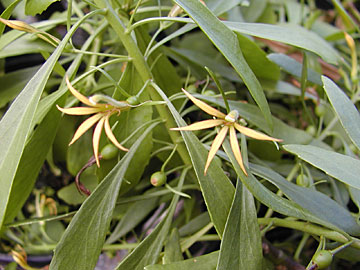|
In The Garden
Rick Barboza
|
Naupaka has flower appeal

HUI KU MAOLI OLA
Naupaka kuahiwi
Scaevola gaudichaudii
Mountain naupaka
|
|
Small shrubs, 3 to 4 feet tall with narrow leaves that are slightly serrated toward the tip. The most appealing feature of this native plant is its fragrant yellow "half-flowers." Compared with the other eight native species of naupaka, six of which are also mountain-dwelling, this species is the most striking, with the most narrow and pointed petals. Two other species are the common coastal naupaka kahakai (Scaevola sericea) and the endangered dwarf naupaka (Scaevola coriacea), also found near the ocean.
Distribution: This endemic species is found on all the main islands, except Niihau and Kahoolawe, in dry-to-mesic forests, quite unlike its other mountain naupaka relatives, which reside mostly in higher, wetter areas.
Landscape use and care: Naupaka makes an excellent addition to any yard, whether you're a collector of native plants or not. They require little water once established and love full sun. Many times people plant coastal naupaka kahakai on the makai side of the house and naupaka kuahiwi on the mauka side. This species seems to be the hardiest among naupaka, for its seeming resistance to mites and other pests that crinkle and deform other naupaka leaves.
Cultural uses: The fragrant flowers of various naupaka kuahiwi are used in leis as seen in the new book "Na Lei Makamae," by Marie McDonald and Paul Weissich (a definite must-have for everyone, especially hula dancers, native-plant collectors, lei makers and Hawaiian-culture enthusiasts).
Additional info: All nine species of native naupaka are believed to have come from only three separate colonizations. All but one species is endemic; the common coastal naupaka (S. sericea) is indigenous and represents one of the three colonizations. Because its fruit float, it probably reached Hawaii from other places in the Pacific on several occasions. The other colonization is believed to be for 'ohe naupaka (S. glabra), and the third represents the remaining native species in which one pioneer species radiated into many other species.
Rick Barboza co-owns Hui Ku Maoli Ola, a native Hawaiian plant nursery, with Matt Schirman. Contact him at 259-6580 or e-mail
rickbarboza@aol.com.

